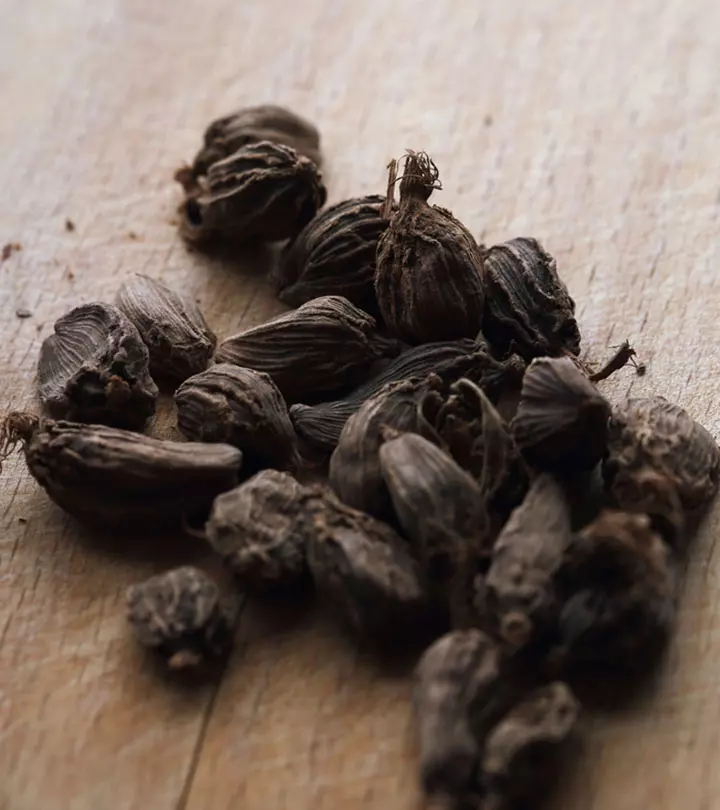Top 7 Side Effects Of Tamarind
Take a deep dive into the impact of overindulging on these tangy treats.

Image: Midjourney/ StyleCraze Design Team
Tamarind adds that tangy zest to many soups and gravies, especially in the Indian cuisine! Added to chutneys and condiments, it makes your meals burst with nutrition, flavor, and zing! Tamarind is traditionally used to alleviate diarrhea, stomach cramps, bloating, and dizziness (1). However, too much consumption can lead to certain side effects of tamarind! While most of us might be unaware, there are certain things you need to keep in mind if you like having tamarind too often! Read on to find out more!

 Know The Flip Side: Tamarind
Know The Flip Side: TamarindShort-Term Effects
Itching, rashes, dizziness, breathlessness, vomiting, acidity, and weaver’s cough.
Long-Term Effects
May aggravate tooth enamel erosion, slow blood flow, or block blood vessels.
Drug Interactions
Excessive tamarind intake may interact with medications such as antibiotic, antiplatelet, and anti-inflammatory drugs and laxative products.
When To See A Doctor
If you experience excessive abdominal pain, hives, difficulty breathing, or very low blood sugar levels (especially if you have diabetes).
In This Article
7 Side Effects Of Tamarind
While tamarind has many known benefits, there is another side to the coin as well. Let us know about the most common tamarind side effects:
1. May Cause Allergic Reactions

Allergy or hypersensitivity is one of the most common side effects of tamarind (1). There are lots of people who are sensitive to the ingredients of this fruit and end up developing a number of symptoms like rashes, itching, inflammation, stinging sensation, lightheadedness, fainting, vomiting, shortness of breath, etc. by consuming it.
 Did You Know?
Did You Know?2. May Damage Tooth Enamel

Tamarind is highly acidic by nature. Therefore, the chance is big that it will take a toll on your beautiful sets of teeth with over consumption. If you eat tamarind in excessive quantity, the enamel of your teeth is likely to get corroded by its acid component. Remember, too much tamarind is extremely bad for the health as well as for the look of your teeth.
3. Induces Acid Reflux

As said earlier, tamarind is an acidic food element. When we eat it, the acid levels go up within our gastrointestinal tract, especially our stomach. So, if you are already suffering from digestive issues like gastroesophageal reflux disease (GERD)i A digestive disease in which the stomach acid frequently flows back up the food pipe and irritates the lining. or ‘acid reflux’, you should stay away from it. Otherwise, you will end up developing acute acidity.
4. Promotes Vasoconstriction
If you are taking any sort of vasoconstrictor (no matter whether it is an herb, a supplement or a synthetic drug), you should strictly steer clear of tamarind (2). This fruit is known to add to the vasoconstricting effects by accelerating the process of narrowing of the blood vessels. It ultimately results in slow blood flow or sometimes even complete blockage of blood vessels.
5. Interacts With Certain Antibiotics

If you are using any ophthalmic antibiotici Solutions or ointments that are used to treat and prevent bacterial infections in the eyes. on your eyes topically, avoid tamarind intake. Several researchers have shown that this fruit interacts with such type of drugs and can lead to unwanted skin as well as health hazards.
6. Produces Laxative Effects
The pulp or extract of tamarind is well-known for its laxativei A substance, property, or medication that is used to loosen stool and improve bowel movements. qualities and can be helpful in treating constipation (4). But if you are already using any other laxative product, make sure that you skip eating this fruit.
7. Can Make Weaver’s Cough Worse

Well, weaver’s cough is not caused by the intake of tamarind. Rather, it is a medical condition resulted from the powdered tamarind seeds. However, if you are going to use it in your dishes as an additive, be careful as the powder can affect your lungs and induce chronic respiratory issues (2).
 Quick Tip
Quick TipAlthough tamarind is a flavorful and nutritious ingredient, knowing how to minimize its risks can help you enjoy it without adverse effects. Scroll down to learn more.
Key Takeaways
- Tamarind’s acidic contents may cause digestive issues and corrode tooth enamel.
- It may interfere with antibiotics and worsen digestive issues and weaver’s cough.
- Tamarind may also cause allergic reactions like rashes and itching in some individuals. It is important to seek medical attention if these symptoms occur.
How To Minimize Risks When Consuming Tamarind
The following precautions can ensure that you enjoy the flavors and benefits of tamarind with minimal risks to your health.
- Purchase tamarind from reliable companies and look for labels that ensure their quality, such as an “organic” label or FDA approval.
- Opt for fresh tamarind pods or unsweetened tamarind paste to avoid excess sugar.
- Avoid eating tamarind on an empty stomach and minimize your intake if you have a sensitive stomach or acid reflux.
- Refrigerate the tamarind paste in an airtight container and keep the tamarind pods in a cool, dry location.
- Always look for and remove any seeds before consuming tamarind or using it in recipes.
Infographic: What You Should Consider Before Using Tamarind
Tamarind is a tangy-flavored fruit with many nutritional benefits. However, excess consumption may cause several adverse effects, including allergic reactions, nausea, and interactions with certain medications. Hence, you must consider a few things before consuming tamarind to avoid its negative effects. Click on the infographic below to learn more about the same.
Some thing wrong with infographic shortcode. please verify shortcode syntax
Tamarind adds a tangy flavor to savory dishes, however, excess consumption may lead to adverse reactions. The side effects of tamarinds range from inducing acid reflux to a high risk of dental problems. It may have laxative effects and may worsen the weaver’s cough. Tamarind may act as a vasoconstrictor and lead to narrowing of the blood vessels. In some cases, tamarind may trigger allergic reactions or interfere with the functioning of certain medications, especially antibiotics. If possible, try to limit your intake or stay away from it entirely to avoid such complications.
Frequently Asked Questions
Is it good to eat tamarind every day?
Yes, eating tamarind every day is good as it offers an array of health benefits. It contains antioxidants that may boost heart and bone health. However, if consumed in excess, it may cause side effects like acid reflux and damage to the teeth.
How much tamarind should I eat daily?
Tamarind is good for weight loss. It has many health benefits. However, it needs to be consumed in moderation. You can eat 10 grams of tamarind daily.
Is tamarind good for the kidneys?
Yes, tamarind is loaded with antioxidants that can promote kidney health.
How does tamarind affect digestion?
It helps maintain a healthy balance of good bacteria in your gut and encourages the production of beneficial substances that aid in digestion. Tamarind promotes a healthy gut environment by reducing inflammation and supporting the strength of your digestive tract (5). However, it may lead to discomfort if consumed in excess.
Can tamarind increase breast size?
No, tamarind cannot increase breast size.
Who should not eat tamarind?
Tamarind may lower blood sugar levels way too much if consumed in excess. Hence, people with diabetes should monitor their blood sugar levels while eating tamarind.
Is tamarind good for the liver?
Yes, tamarind is good for the liver if consumed in moderation.
Illustration: Side Effects Of Tamarind

Image: Stable Diffusion/StyleCraze Design Team
Tamarind may taste delicious, and tamarind seeds have many benefits too, but too much of it is not good for your health. Watch this video to learn about tamarind’s negative impact on your health and well-being.
References
Articles on StyleCraze are backed by verified information from peer-reviewed and academic research papers, reputed organizations, research institutions, and medical associations to ensure accuracy and relevance. Read our editorial policy to learn more.
- Antiulcer effect of the methanolic extract of Tamarindus indica seeds in different experimental models
https://www.ncbi.nlm.nih.gov/pmc/articles/PMC3103918/ - Association of bronchial asthma and allergic rhinitis with IgE mediated allergy to common food allergens
https://ijmrr.medresearch.in/index.php/ijmrr/article/view/533/1034 - Tamarindus indica and its health related effects
https://www.sciencedirect.com/science/article/pii/S2221169115300885 - Tamarindus indica Extent of explored potential
https://www.ncbi.nlm.nih.gov/pmc/articles/PMC3210002/ - Dynamic digestion of tamarind seed polysaccharide: Indigestibility in gastrointestinal simulations and gut microbiota changes in vitro
https://pubmed.ncbi.nlm.nih.gov/32414435/
Read full bio of Karishma Shah
Read full bio of Tanya Choudhary
Read full bio of Ravi Teja Tadimalla
Read full bio of Moksha Gandhi


























Community Experiences
Join the conversation and become a part of our empowering community! Share your stories, experiences, and insights to connect with other beauty, lifestyle, and health enthusiasts.